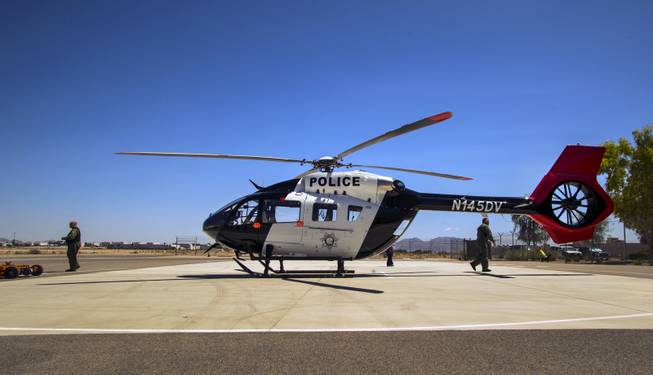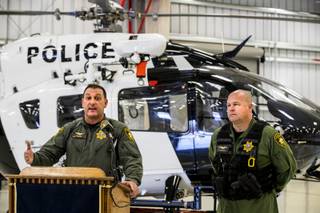
LVMPD co-pilot Bryan Woolard and chief pilot Steve Morris Jr. prepare their new twin-engine H145 Airbus Helicopter for use in the Air Support Detail based out of the North Las Vegas Airport on Wednesday, Aug. 16, 2017.
Thursday, Aug. 17, 2017 | 2 a.m.
Up in the sky, look: It’s not a bird. It’s not a plane. But Metro Police’s latest airborne toy does share some of Superman’s powerful qualities.
The new $9.6 million Airbus H145 Helicopter — the first of its kind in Metro Search and Rescue’s five-helicopter fleet — has two engines, each with the super strength of more than 1,000 horsepower.
“It is a significant advancement to our current capabilities,” said Officer Steve Morris Jr., chief pilot of Metro’s Air Support Section. “This is a very capable helicopter, and it fills some big shoes.”
Metro exhibited the new bird Wednesday at the North Las Vegas Airport, which serves as Metro’s base for an average of 120 annual search-and-rescue flights. Almost all of those flights assist stranded or injured hikers in Red Rock Canyon and Mount Charleston, Morris said.
The new helicopter features a Fenestron, a protected tail rotor for a quieter flight. It also helps ensure the safety of those walking near the chopper because it shields the tail blades, unlike traditional helicopter models, Morris said.
The tail number bears the initials of Metro Officer David Vanbuskirk, who died during a July 2013 rescue mission in Mount Charleston when he became detached from a hoist cable line while rescuing a stranded hiker and fell to his death.
Officer Bryan Woolard, who served as Morris’ co-pilot during Wednesday’s demonstration, co-piloted the flight during which Vanbuskirk lost his life.
“It was important for us to memorialize him, so his memory will remain with us for the life of the helicopter,” Woolard said.
Three of the other four search-and-rescue helicopters were manufactured in the 1970s and have been in use for more than 30 years. The fourth was purchased in 2015. Morris hopes the new chopper will also serve the force for three decades.
Morris said the H145 is more precise than the rest of the fleet and can fit into tighter spots in uneven canyon and forest landscapes. It’s a “last option” for authorities, who prefer the less expensive route of locating and rescuing hikers using ground methods. But ground rescue is only feasible for about 50 of the average 170 annual operations, he said, leaving the rest to the helicopters.
Unlike Superman, the H145 won’t be saving many people in the city. Although it’s labeled for “multipurpose use,” including patrol coverage to help officers on the ground catch suspects of violent crimes, the new chopper spends too much fuel for such missions, Morris said.
“Many times the helicopter is the first police resource to arrive on a search-and-rescue scene before any ground units do,” he said. “We provide that insight and give that necessary information to the other units.”


Join the Discussion:
Check this out for a full explanation of our conversion to the LiveFyre commenting system and instructions on how to sign up for an account.
Full comments policy